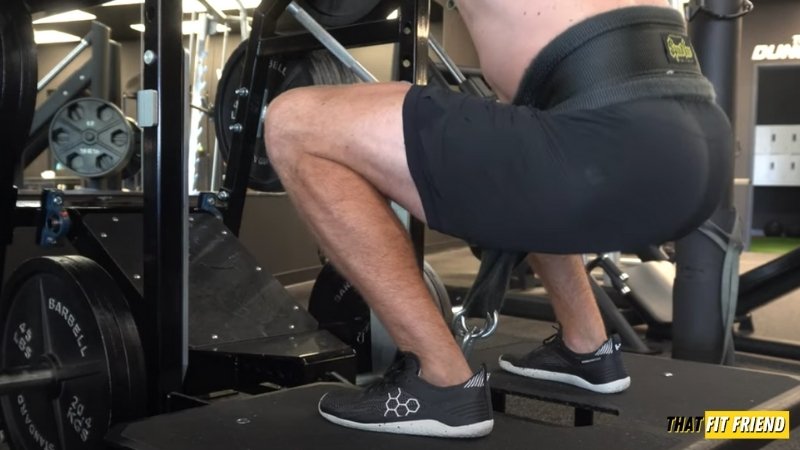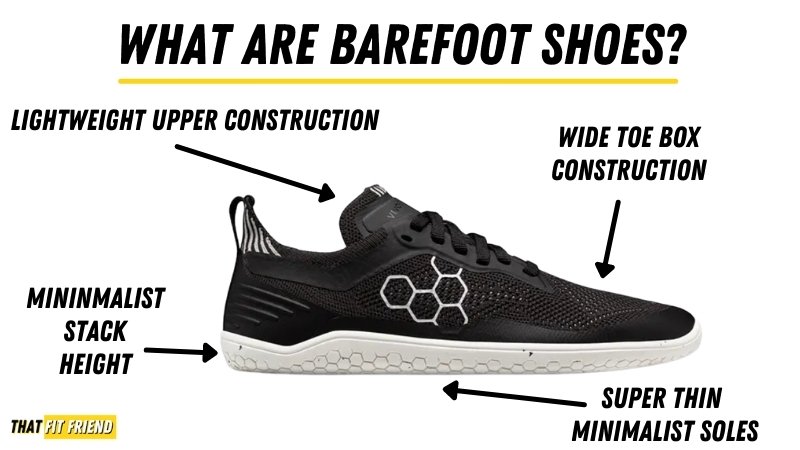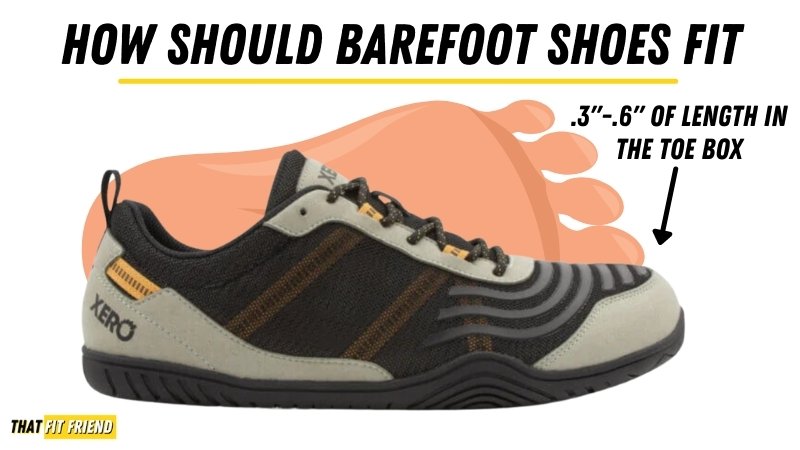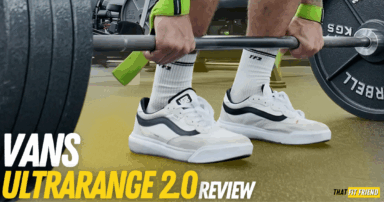Barefoot shoes continue to grow in popularity for training, hiking, and daily wear. This type of footwear comes with multiple proposed benefits and understanding these benefits, how barefoot shoes should fit, and how to properly acclimate to them can be incredibly important for your barefoot shoe experience.
In my opinion, when you’re transitioning to barefoot shoes, the acclimation period is the most important. After years of wearing barefoot shoes, a background in Sports Science, and helping friends and personal training clients implement barefoot shoes into their shoe rotation — I’ve built out an acclimation framework to work off of.
On my YouTube channel, I’m frequently asked questions about barefoot shoes and barefoot shoe lovers constantly share their experiences in these shoes. Outside of my own experiences, it’s been great getting to synthesize the information shared by the community.
For the Record
- I’m a strength coach with an MS in Sports Science and a BS in Exercise Science. In school, I was always fascinated with biomechanics and, more specifically, how shoes can influence performance and movement patterns. I’ve used my educational background extensively in developing guides like this and my reviews.
- I look at barefoot shoes as tools, so I rotate them with other shoes like cross-training shoes, running shoes, and weightlifting shoes, depending on what I’m doing in the gym and on my day-to-day. This helps me stay more objective with their usage and avoids the “all-or-none” mindset I see far too often with barefoot shoe users.
- As you read over my acclimation guide, please remember how nuanced everyone’s experience can be. I want this guide to serve as a jumping-off point for you and your barefoot shoe journey, and it shouldn’t be taken as the “only way” to acclimate, size, etc. As you get more into barefoot shoes, I can’t stress enough to plug and play.
How to Acclimate to Barefoot Shoes
If you’re thinking about investing in and wearing barefoot shoes for the first time, then you’ll want to take a calculated approach when wearing them.
This way, you don’t go all-in too fast and wind up with sore and beat-up feet, and then up despising barefoot shoes. I’ve seen this happen far too often, and this is usually a result of some influencer pushing them hard to make an affiliate sale and not disclosing how to acclimate properly.
I liken wearing barefoot shoes for the first time to learning a new exercise. The muscles supporting the new exercise you’re learning will need time to strengthen and adapt.
You wouldn’t just take a maximal load on something like a back squat and do a high-volume session on your first training day. You’d ease into it and train the muscles to adapt appropriately.
In the case of barefoot shoes, which will come with the use of the smaller muscles in your feet and ankles, which may be undeveloped/not used in this context, the last thing you want is to go all out too fast. There’s a happy medium to find and walk…literally.
Below, I will outline an in-depth three-step approach to adapting to using barefoot shoes. It’s important to note that everyone should work at their own pace when adapting to barefoot shoes, so please don’t rush the process — there’s no need for that.
Step 1: Decide When You’ll Wear Your Barefoot Shoes
The first step is identifying the times in which you plan to wear your barefoot shoes. This step is incredibly important because different activities and environments will require different acclimation periods.
For example, if you just want to wear them on a daily basis, then your timeline will be much different than someone who wants to wear minimalist shoes for training, running, HIIT, and so forth.
When it comes to wearing barefoot shoes in different settings, I like to place certain activities into particular “thresholds” for how intense they’ll be on your feet when adapting.
- Daily Wear: Low Threshold
- Running: High Threshold
- HIIT: High Threshold
- Lifting: Medium Threshold
In this context, I’m putting these activities into thresholds that will require different demands from the muscles of the feet and ankles, and their surrounding connective tissues.
Jumping, running, and doing other high-force-producing activities will take a lot more out of the tissues and muscles compared to something like walking.
Step 2: Account for Your Training History
Once you’ve defined when you want to wear your barefoot shoes, you’ll then want to explore your training background.
Training backgrounds and history can help provide further direction into how long it will take you to acclimate and how hard you can push at the beginning. For this step, we want to specifically explore how often you’re barefoot and how comfortable you are being barefoot.
If you’re someone who’s constantly barefoot and loves doing activities barefoot, then you’ll likely feel much more comfortable in barefoot shoes right away compared to someone who’s never barefoot.
I’d suggest rating your comfort being barefoot with the categories below.
- Very Comfortable: Barefoot often.
- Somewhat Comfortable: Barefoot 1-2x a week for 20-min+ bouts.
- Not Comfortable: Rarely barefoot and not that comfortable being barefoot.
If you’re landing on the “not comfortable” category, then you’ll simply want to acclimate slower to barefoot shoes and start with lower-threshold activities during the initial acclimation period.
Another factor to consider in the context of running and training history is what your normal running gait looks like currently. For example, forefoot and mid-foot runners will often feel naturally more comfortable in barefoot shoes than those who heel strike when running in thicker midsole running shoes.
Step 3: Create an Individual Plan
After answering step one and step two, you should have a loose idea of how to approach the process of acclimating to barefoot shoes. I’m going to provide a few examples below to help you construct a plan that works for you.
Again, though, I can’t stress enough to go at your own pace and to adjust your plan as you go based on the feedback your body, and more specifically, your feet and ankles are giving you.
Case Study 1: Desired Activities: Lifting and Daily Wear | Very Comfortable
For this case study and person, they’ll adapt fast to their barefoot shoes due to them already being comfortable barefoot. Plus, daily wear and lifting are low and medium-threshold activities.
A starting game plan for this case study could look something like this.
- Week 1: 1 Lifting Session, 1 Longer Daily Wear Session
- Week 2: 1 Lifting Session, 2 Longer Daily Wear Sessions
- Week 3: 2 Lifting Session, 2 Longer Daily Wear Sessions
- Week 4: Wear Per Your Wants!
In this case, this lifter will have a much larger range of comfort when wearing their barefoot shoes for the first few weeks.
Case Study 2: Desired Activities: Running | Somewhat Comfortable
High-threshold activities mixed with little exposure or comfort to being barefoot will require the longest timelines. This is why it’s important to understand acclimation periods to avoid jumping in too fast to this footwear style.
In this case study, I’d suggest doing the following.
- Week 1: 1 Shorter Running Session On Grass or Turf (<2 miles)
- Week 2: 2 Shorter Running Sessions On Grass or Turf (<2 miles ea)
- Week 3: 1 Very Short Session On Pavement (<1 mile), 1 Shorter Run On Grass or Turf (<2 miles)
- Week 4: 1 Very Short Session On Pavement (<1 mile), 1 Medium Run On Grass or Turf (2-4 miles)
For these sessions, use your best judgment and try to spread them out. If you’re getting excessively sore after your barefoot running sessions, then it might be a good idea to scale back or spread training sessions far apart.
Case Study 3: Desired Activities: Everything | Not Comfortable
So, you want to make the shift to barefoot shoes full-time, but you have no experience. Where do you start? For this case study, you can take your approach to adapt to barefoot shoes in multiple directions.
An example game plan could look like the following.
- Week 1: 1 Daily Wear Session
- Week 2: 1 Daily Wear Session, 1 Casual Lifting Session
- Week 3: 2 Daily Wear Sessions, 1 Lifting Session
- Week 4: 2-3 Daily Wear Sessions, 1 Lifting Session, and 1 Very Short Run On Turf (<1 mile) or Grass or HIIT Session
By week four, you’ll have multiple exposures to different environments, which can then help direct the following weeks. For example, if you’re fine wearing your barefoot shoes on a daily basis, but notice HIIT sessions produce a ton of fatigue, then you know where to spend a bit more energy on.
What Are Barefoot Shoes?
Barefoot shoes are shoes designed to protect the foot while replicating barefoot movement. Barefoot shoes are also referred to as minimalist shoes.
Footwear can, at times, alter how we move and change our gait depending on the construction details of the shoes being worn. Barefoot shoes are designed to promote natural movement by limiting the material used in shoes and promoting a more “grounded” feeling.
A few construction traits that barefoot shoes possess to replicate barefoot positioning include:
- 0mm heel-to-toe drops
- Minimalist and thin soles
- Minimalist stack heights
- Wide Toe Boxes
All of these construction traits help to replicate what it’s like to move barefoot while also serving to protect the foot from the ground and our external environment.
I like to compare barefoot shoes to really thin gloves. We still have full dexterity in many ways, and there’s only a light layer of protection, so we can still fully feel the world around us.
Why Barefoot Shoes?
Barefoot shoes are interesting because there tend to be a lot of strong opinions around them. Some live and die by barefoot shoes while others think they’re overhyped and not actually beneficial. Who’s right and who’s wrong?
I like to take an approach that sees the middle ground and benefits of both working out in training shoes and barefoot shoes. I think there are contextually appropriate times to where each and if one helps you perform stronger, then that will likely be the best shoe for you in that setting.
When discussing why barefoot shoes and their benefits, I’ll cover a few of the benefits that are related to daily wear and performance output.
1. Improve Proprioception With the Ground
Proprioception is our body’s ability to feel the ground around us to help us move through space and time through a calculated means. Our feet have a ton of mechanoreceptors on them — almost as much as the hands and lips — and these mechanoreceptors help provide the brain with feedback to help you strategically navigate the world.
Let’s say you’re walking barefoot and step on a small rock. The slight difference in surface area and the potential discomfort that you feel through the bottom of the foot then sends messages to the brain, which then helps you manipulate your foot positioning and body to navigate that obstacle per a fluidic means.
In the context of barefoot shoes, this style of footwear’s minimalist construction helps to provide the brain with this heightened level of sensitivity. When we wear shoes with thick midsoles and outsoles, we’re not going to have the same level of perception that we would with barefoot shoes, which can actually hinder our body’s abilities to sense the world around us.
In some ways, it’s the old “use it or lose it” sentiment with mechanoreceptors. If we’re never walking barefoot or using barefoot shoes, our feet can lose out on some of their sensitivity which helps us to sense the world around us.
2. Increase Foot Musculature
Another subtle benefit that comes with barefoot shoes is that they can help strengthen the foot as a whole. There are 29 muscles associated with the foot and ankle and the foot itself has multiple intrinsic muscles that help provide it with its structure, shape, and function.
When we wear thicker shoes day in and day out, we can lose out on training some of the deeper foot muscles. By opting for barefoot shoes here and there, we can help hedge our bets for ensuring that we’re training the foot musculature of the foot on a weekly basis.
The intrinsic muscles of the foot can be strengthened and trained by exposing the foot to variability. Basically, we can train the foot subtly by wearing barefoot shoes due to their thin soles exposing the foot to the variability of the ground. By constantly changing shape to accommodate natural movement, our feet can be trained by simply wearing these shoes.
3. Promote Natural Gait and Movement Mechanics
When we walk wearing barefoot shoes, our gait can, at times, be slightly different than our gait when wearing shoes. For example, if we’re wearing thicker shoes with a high heel-to-toe drop, then our ankles will take a slightly more plantarflexed position.
This slight plantarflexed orientation, when at rest, can then change our ankle and foot mechanics during our gait cycle.
This is NOT to say that wearing shoes is bad for our gait or lower body movement mechanics, more so, that it can be useful to create a little gait variability and train with different footwear.
When we lift, play sports, and move on a daily basis, our gait and lower body mechanics will constantly change to accommodate the task at hand. By exposing the body to different footwear options, we can broaden our abilities to move with different lower body orientations which can be beneficial for performance output.
From a coaching point of view, this is where it’s also important to conceptualize your goals with what types of footwear help you perform your best. I think there’s a context where everyone can use barefoot shoes sparingly to gain benefits without having to change everything about their performance and footwear preferences.
How Should Barefoot Shoes Fit?
I always recommend sizing your barefoot shoes similarly to how you size your cross-training shoes. A good rule of thumb is to have between .3″-.6″ of wiggle room in the toe.
Since most of us will be using our barefoot shoes in a variety of environments, I think it’s important to find a size that’s comfortable for things like daily wear and the other activities in which you’ll be wearing them.
For example, if you like to have a little bit of room at the toe in your cross-training shoes for things like HIIT and daily wear, and you plan to use your barefoot shoes similarly, then you’ll want to size them the same.
Where to Buy Barefoot Shoes?
As of right now, the barefoot shoe industry is in a really interesting growth period. I think more companies are starting to produce more barefoot shoes and multiple companies only focus on barefoot shoes.
In the world of strength training, companies like Xero Shoes and Vivobarefoot are helping to move the needle forward with their innovative models. I’ve published multiple reviews on their shoes and I’d highly suggest checking them out and starting there if you’re interested in buying barefoot shoes.
How Should You Walk In Barefoot Shoes?
When wearing barefoot shoes and walking, you’ll want to assume a normal gait pattern that you would use when walking barefoot. You do not need to overanalyze your stride or change how you walk solely due to wearing barefoot shoes.
The best way to conceptualize walking in barefoot shoes is to assume you’re barefoot and just walk. If you’re not used to wearing barefoot shoes, then I would suggest starting with softer surfaces like turf, tracks, or grass, and then progressing from there once you feel comfortable walking with barefoot shoes.
Takeaway Thoughts
Barefoot shoes can be a great tool for strengthening the feet and exposing them to variable environments. When exploring barefoot shoes, I can’t stress enough to ease into wearing them so your intrinsic foot musculature and tissues can acclimate properly.
If you have any questions about barefoot shoes, drop comments below or reach out to me personally via Instagram (@jake_boly) and I’ll help where I can.













Moe Jaber
Hi! Fantastic article. I’ve been eager to jump into a pair of barefoot type shoes, this information is great. One question , what about socks? Are they recommended? If so, should they be the socks?
Hey, thank you! That’s awesome — make sure you take time acclimating. Regarding sock use, it can vary from shoe to shoe. If I’m rotating models and they’re breathable then I’ll go sockless and with socks depending on my outfit and the vibe. I do try to rotate, though, so I’m not wearing the same shoe everyday sockless (that’s when odor can be a thing). I think once you land on a pair you’ll be able to tell pretty quick if they’re going to be comfy with/without socks, too. If you need some cheap no-shows, I rock the motee & zconias from Amazon. Cheap and they tend to last a while!
Neil McCallum
I have recently bought a pair of Vivo barefoot geo kit shoes and I’m unsure if they are too big. I have approximately 1 inch between the big toe and the end of the shoe. Should I size down in the shoes? When my toes are close to the end of the shoe I can slide a finger down the back of the shoe at my heel. I know they are wider than my normal shoe but how tight do I need to tie the shoes?
Hey, Neil! I had the same issue in my Geo Racer Knit and it really depends on what you’re willing to tolerate and if it hinders performance. If you find that the knit isn’t locking the foot down well or that it feels “floppy” then I’d size down. Plus, with knit uppers, you generally want a little more hug with them to avoid running into upper security issues when training. Just my two cents. You could definitely stay at that size if it doesn’t bother you, just depends on what you want em’ for and how you plan to use them/if their length will hinder your abilities.